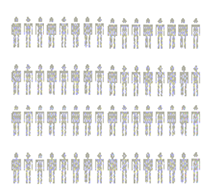Main Content
Lesson 1: Decision Making Under Uncertainty
Basic Concepts in Statistics
Let's now start with the fundamentals of statistics. The foundation of all statistical analysis is the concept of population and sample.
Populations and Samples
For any study of statistics, we must first define some common terms. Statistics are measurements of some kind of variables taken from samples. Those samples are drawn from a given population. Let's define the population and sample.
Population
A population is the group of all items of interest to a statistics practitioner. A population is frequently very large, sometimes infinite. For example, the Census Bureau estimated that there were 245.5 million Americans ages 18 and older in November 2016, so the population of eligible U.S. voters is 245.5 million (Pew Research Center FactTank, 2018). Similarly, all customers or all employees of a company can be considered as the population representing the customers and employees of that company, respectively. Measures used to describe the population are called parameters.-

Figure 1.4. Population
- Parameter
- A parameter is a descriptive measure of a population.
Examples of population parameters:
- Facebook wants to estimate the average amount of time women spend on the site each day (population parameter).
- Macy’s wants to estimate the average amount a customer spends in its stores during the summer weekends (population parameter).
Sample
A sample is a subset of the population. A sample is potentially very large, but less than the population. For example, samples of a few hundred voters from an exit poll on election day throughout the country. A measure computed from sample data is called a statistic.-

Figure 1.5. Sample
- Statistic
- A statistic is a descriptive measure of a sample.
Examples of sample statistics:
- From a random sample of 50 female Facebook users, the company obtained a sample average of 30 minutes/day (sample statistic).
- A random sample of 250 customers was taken from different parts of the country during the Saturdays and Sundays of July and August. The average customer spent $300 (sample statistic).
